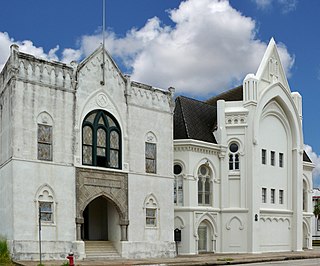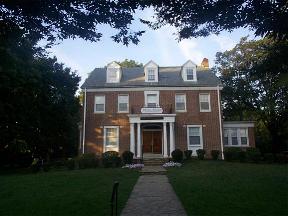Jews in Philadelphia can trace their history back to Colonial America. Jews have lived in Philadelphia since the arrival of William Penn in 1682.
Abraham Cohen Labatt was an American Sephardic Jew who was a prominent pioneer of Reform Judaism in the United States in the 19th century, founding several early congregations in the South and in San Francisco after the Gold Rush. A merchant, in the 1830s he helped pioneer trade between United States interests in Charleston and those in Texas and Mexico.
The history of Jews in Ohio dates back to 1817, when Joseph Jonas, a pioneer, came from England and made his home in Cincinnati. He drew after him a number of English Jews, who held Orthodox-style divine service for the first time in Ohio in 1819, and, as the community grew, organized themselves in 1824 into the first Jewish congregation of the Ohio Valley, the B'ne Israel. This English immigration was followed in the next two decades by the coming of German immigrants who, in contrast, were mostly Reform Jews. A Bavarian, Simson Thorman, settled in 1837 in Cleveland, then a considerable town, which thus became the second place in the state where Jews settled. Thorman was soon followed by countrymen of his, who in 1839 organized themselves into a congregation called the Israelitish Society. The same decade saw an influx of German Jews into Cincinnati, and these in 1841 founded the Bene Yeshurun congregation. To these two communities the Jewish history of Ohio was confined for the first half of the 19th century. In 1850 Ohio had six congregations: four in Cincinnati and two in Cleveland.

Agudath Israel Etz Ahayem, transliterated from Hebrew to mean the Congregation of Israel Tree of Life, is a Conservative Jewish synagogue located at 3525 Cloverdale Road in Montgomery, Alabama, in the United States.

Congregation B'nai Israel is a Reform Jewish congregation and synagogue located in Galveston, Texas, in the United States. Organized by German Jewish immigrants in 1868, it is the oldest Reform congregation and the second chartered Jewish congregation in the state.
Jewish Texans have been a part of the history of Texas since the first European explorers arrived in the region in the 16th century. In 1990, there were around 108,000 adherents to Judaism in Texas. More recent estimates place the number at around 120,000.

Henry Cohen was a British-American rabbi, scholar, community activist and writer who served most of his career at Congregation B'nai Israel in Galveston, Texas, from 1888 to 1949. He came to the United States in 1885, during a period of rapid and massive growth related to early 20th-century immigration from eastern and southern Europe. In Texas, he organized the Galveston Movement, which worked from 1907 to 1914 to attract eastern European Jewish immigrants to Galveston and the Gulf Coast as a destination, as an alternative to the better known Northeastern cities. Ten thousand such immigrants entered at Galveston.

James Lee Kessler, the founder of the Texas Jewish Historical Society, was the first native Texan to serve as rabbi of Congregation B'nai Israel in Galveston, Texas.

Congregation Beth Jacob is a Conservative Jewish synagogue located at 2401 Avenue K, Galveston, on Galveston Island, Texas, in the United States. The present synagogue was built by Austrian, Russian and Hungarian immigrants in 1931. It was listed on the National Register of Historic Places in 2024.
The Texas Jewish Historical Society,, which began in 1980, is a society dedicated to the preservation of Jewish history in Texas.
The history of the Jews in Brenham, Texas; covers a period of over 140 years. As one of the first areas in Texas, outside of major population centers, to develop a sizable Jewish population, the community boasts many things of historical note. The Brenham community was formally organized in 1885.
Dallas is the second-largest city in Texas and has one of the largest Jewish communities in the state.

B'nai Jeshurun is a non-denominational Jewish synagogue located at 257 West 88th Street and 270 West 89th Street, on the Upper West Side of Manhattan, in New York City, New York, United States.
David Lefkowitz was a rabbi who led Temple Emanu-El in Dallas, Texas from 1920 to 1949, after having worked at Temple Israel in Dayton, Ohio. He opposed the rise of the Ku Klux Klan, which had been revived in 1915; it was strongly opposed to immigrants from eastern and southern Europe who were Jews and Catholics. He was a Founding Executive Committee Member of the Dayton Branch of the National Association for the Advancement of Colored People (NAACP).

Congregation Beth Israel is a Reform Jewish congregation and synagogue located at 5600 North Braeswood Boulevard, in Houston, Texas, in the United States. The congregation, founded in 1854, is the oldest Jewish congregation in Texas; and it operates the Shlenker School.

The Galveston Movement, also known as the Galveston Plan, was a U.S. immigration assistance program operated by several Jewish organizations between 1907 and 1914. The program diverted Jewish immigrants, fleeing Russia and eastern Europe, away from East Coast cities, particularly New York. During its operation, ten thousand Jewish immigrants passed through the port of Galveston, Texas, about a third the number that emigrated to Palestine during the same period. New York financier and philanthropist Jacob Schiff was the driving force behind the effort, which he supported with nearly $500,000 of his personal fortune. B'nai Israel's Rabbi Henry Cohen was the humanitarian face of the movement, meeting ships at the Galveston docks and helping guide the immigrants through the cumbersome arrival and distribution process, and on into the countryside.

B'nai Israel Traditional Synagogue is a Conservative synagogue located at 1907 Vance Ave, Alexandria, Louisiana, in the United States. It was founded in 1913 as an Orthodox synagogue by Jews from Poland and Russia, many of whom arrived in Alexandria and Central Louisiana as part of the Galveston Movement. In the 1950s the congregation became Conservative.

The Jewish community of Houston, Texas has grown and thrived since the 1800s. As of 2008, Jews lived in many Houston neighborhoods and Meyerland is the center of the Jewish community in the area.

Few Jews arrived in Baltimore, Maryland, in its early years. As an immigrant port of entry and border town between North and South and as a manufacturing center in its own right, Baltimore has been well-positioned to reflect developments in American Jewish life. Yet, the Jewish community of Baltimore has maintained its own distinctive character as well.
Black Jews in New York City comprise one of the largest communities of Black Jews in the United States. Black Jews have lived in New York City since colonial times, with organized Black-Jewish and Black Hebrew Israelite communities emerging during the early 20th century. Black Jewish and Black Hebrew Israelite communities have historically been centered in Harlem, Brooklyn, The Bronx, and Queens. The Commandment Keepers movement originated in Harlem, while the Black Orthodox Jewish community is centered in Brooklyn. New York City is home to four historically Black synagogues with roots in the Black Hebrew Israelite community. A small Beta Israel (Ethiopian-Jewish) community also exists in New York City, many of whom emigrated from Israel. Black Hebrew Israelites are not considered Jewish by the New York Board of Rabbis, an organization representing mainstream Rabbinic Judaism. However, some Black Hebrew Israelite individuals in New York City are recognized as Jewish due to converting through the Orthodox, Conservative, or other Jewish movements.











